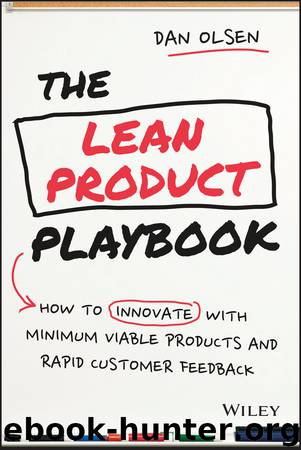The Lean Product Playbook by Dan Olsen

Author:Dan Olsen
Language: eng
Format: epub
ISBN: 9781118960967
Publisher: Wiley
Published: 2015-06-02T00:00:00+00:00
How to Recruit Customers in Your Target Market
Of course, you want to make sure that the customers with whom you are testing are in your target market. Otherwise, their feedback could send you iterating in the wrong direction. You can ensure a good fit by using a screener—a set of questions, like a survey, that you ask prospective participants. For example, if you were targeting younger males, you would ask questions about age and gender. You create multiple-choice answers for each question and decide which answers qualify versus disqualify respondents from your target market. Chapter 3 discussed the different types of customer attributes you can use to specify your target customer.
In addition to demographic attributes, behavioral attributes are typically very useful. If, for example, you were targeting hardcore videogamers, you would probably ask, “Do you play videogames?”, and filter out people who replied “no.” You might then ask people who replied “yes,” “In a typical week, how many hours per week do you play videogames?” The respondents would select from a list of possible responses such as “less than 5 hours per week,” “5 to 10 hours per week,” “10 to 20 hours per week,” “20 to 30 hours per week,” and “over 30 hours per week.” You could decide that gamers need to play 20 or more hours per week to be in your target market, and therefore only accept people who selected the last two choices.
Psychographic attributes—users' opinions and feelings—can also be useful for screening. Sticking with the same target customer, one possible psychographic question could be, “Do you consider yourself a hardcore gamer?” You could also ask, “How much do you enjoy playing videogames?” and provide a scale for responses.
You should refer to the personas you created for your target market as you develop your screener questions. As with everything else, the screener questions serve as hypotheses for you to test and iterate. If you notice while running your initial user tests that your first set of screener questions didn't get you the right kind of customer, then you should change them for the next round of tests.
You'll often discover additional criteria to add to your screener after your first tests. For example, let's say we had a portfolio management application targeted at investors. Our first screener might ask questions about trading frequency and portfolio value. We discover after our first set of user tests that there are two distinct types of investors: those that like to make their own investing decisions, and those that prefer to delegate decisions to a professional advisor. Our value proposition resonates with the first group but is not appealing at all to the second group. For subsequent user tests, we would add a question to our screener to target the do-it-yourself investors and filter out the delegators. We should update our persona accordingly, too.
Once your screener reflects the customers from whom you'd like to get feedback, the next step is to recruit them. This can be the most challenging step for many people who are excited about Lean user testing.
Download
This site does not store any files on its server. We only index and link to content provided by other sites. Please contact the content providers to delete copyright contents if any and email us, we'll remove relevant links or contents immediately.
| Direct | Global |
| Industrial | Multilevel |
| Product Management | Research |
| Telemarketing | Web Marketing |
Influence: The Psychology of Persuasion by Robert B. Cialdini(4736)
The Miracle Morning by Hal Elrod(4675)
The Hacking of the American Mind by Robert H. Lustig(4338)
Pre-Suasion: A Revolutionary Way to Influence and Persuade by Robert Cialdini(4183)
Unlabel: Selling You Without Selling Out by Marc Ecko(3625)
Ogilvy on Advertising by David Ogilvy(3552)
Hidden Persuasion: 33 psychological influence techniques in advertising by Marc Andrews & Matthijs van Leeuwen & Rick van Baaren(3518)
Purple Cow by Seth Godin(3167)
Who Can You Trust? by Rachel Botsman(3111)
Kick Ass in College: Highest Rated "How to Study in College" Book | 77 Ninja Study Skills Tips and Career Strategies | Motivational for College Students: A Guerrilla Guide to College Success by Fox Gunnar(3099)
The Marketing Plan Handbook: Develop Big-Picture Marketing Plans for Pennies on the Dollar by Robert W. Bly(3005)
This Is Marketing by Seth Godin(2993)
I Live in the Future & Here's How It Works by Nick Bilton(2960)
The Power of Broke by Daymond John(2932)
The Tipping Point by Malcolm Gladwell(2870)
Building a StoryBrand by Donald Miller(2862)
The 46 Rules of Genius: An Innovator's Guide to Creativity (Voices That Matter) by Marty Neumeier(2817)
Draw to Win: A Crash Course on How to Lead, Sell, and Innovate With Your Visual Mind by Dan Roam(2756)
Market Wizards by Jack D. Schwager(2670)
